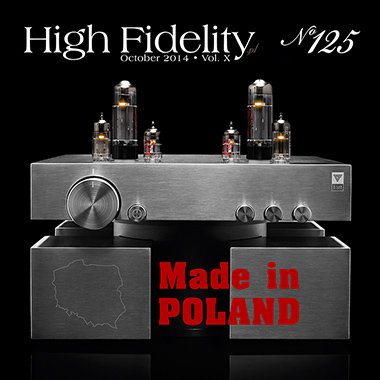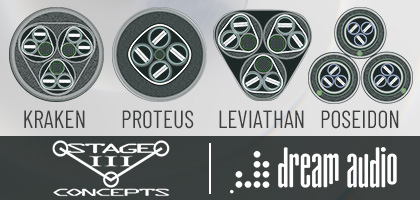No. 242 July 2024
- COVER REVIEW: Ferrum WANDLA GOLDENSOUND EDITION ⸜ digital-to-analog converter » POLAND
- AUDIO SHOW ⸜ coverage: HIGH END 2024 ⸜ Munich » GERMANY
- REVIEW: Daniel Hertz MARIA 350 ⸜ integrated amplifier » ITALY
- REVIEW: Lumin P1 MINI ⸜ file player » HONG KONG
- REVIEW: Thunder Melody AC FEMTO BLACK (2024) ⸜ AC power cable » POLAND
- REVIEW: Laiv HARMONY DAC ⸜ digital-to-analog converter » SIGAPORE
- MUSIC ⸜ review (in Polish): Three Blind Mice: KOSUKE, MOTOHIKO, YAMAMOTO ⸜ remaster 2024 • SACD/CD » JAPAN


|

|
|
|
KING ROGER i RCM AUDIO SENSOR PRELUDE IC,
a.k.a. the amplifier and its maker

The ancient Greeks, the fathers of the Euro-American culture, valued beauty that wasn't seen, but rather “known”. The shapes of buildings, sculptures, and city plans spoke on a plane much deeper than just being aesthetically pleasing – they were supposed to be perceived with the senses. Beauty was searched for in mathematically calculated proportions, as mathematics was also understood to be an art. An ancient Greek looked at a temple, at its shape, at its entrance, and he felt the beauty trapped within its form, which was merely a method of expressing proportions and harmony through mathematical calculations, for example the “golden ratio” rule or the three planes of a cube. Does this mean that they were the first creators of conceptual art, art that isn't intended to be received by uneducated mass audience? Does this mean that their art was incomprehensible for those who weren't ever told about this “known” value? The answer is both yes and no. The genius of an artist, in my opinion, lies within his or her ability to convey the aforementioned non-material “forms” in a way comprehensible even for the masses. And it's entirely up to the artist, whether the used language of aesthetic forms will speak to the audience, whether it will be something they can understand and appreciate, something communicative enough to at least partially transport the member of the audience into the artist's own, inner world. In modern times, ancient Greek art is viewed by millions of tourists in museums. Regardless of their interest in ancient art history or their education and aesthetic preferences, people love ancient art, falling for its “unexplainable” charm and power. Despite the passage of thousands of years, the beauty locked within these artefacts is timeless and universal, and is still as strong as ever. In ancient Greece, beauty was associated with good! Król Roger (King Roger) is, and I'm only saying this for clarification's sake, a piece by Karol Szymanowski, whose libretto was composed in cooperation with Jarosław Iwaszkiewicz. Both gentlemen were under the influence of Nietzsche's ideology, which was very much in vogue at the time. I intentionally avoid using the word “opera”, because – for starters – the piece doesn't follow a scheme typical for this genre, and second of all, Szymanowski himself didn't want it called an opera piece. And what does it have to do with the art of the ancient Greeks? A whole lot, actually! Both the characters, as well as all of the scenery are merely methods, understood by the human senses as a path for conveying the main themes and meaning – that being the struggle of the human soul between what’s “apollineo” and what’s “dionisiaco”. 
Szymanowski took up a neck-breaking – for his times – task of trying to make the main character of a performed piece something beyond the material world: human emotions, dilemmas, and internal conflict which plays out in the soul or in one's head, if you prefer. The piece is non-literal and ambiguous in both its content, but also in its ending, where the author chose not to give the audience the comfort of a “how to fix your life” ending. What kind of person you have to be to design an audio component? Do you have to be a die-hard music lover, overtaken by the passion of Dionysus, or a cold, calculating engineer dealing in the service of Apollean technology? This question binds the seemingly unrelated themes of this article into a whole. Is there a fight – much like the one in King Roger – going on in the head of every engineer/creator or should we call them artists? 
The effect is impressive, as long as you don't get a Pagani Zonda parking next to you, for example. Its owner cannot pull out his credit card and proudly show you that every slit and crevice in the car is even and perfectly narrow. But he can be sure that in his Zonda it was Horacio Pagani himself – the owner and main designer of Zonda – who “screwed in” the last part, and that each Pagani Zonda was personally tested by him before being passed on to its future owner! |
The RCM SENSOR PRELUDE IC H-F 10/10 arrived at my house by post. When its creator, Mr. Roger Adamek, arrived at my doorstep around three weeks later, I had the impression that I'd known him for ages – the SENSOR managed to “tell me” quite a lot about him! I wouldn't want to copy the component's review which had already been written a few years ago by none other than the editor-in-chief himself. That's why I'll just write down three words: energy, openness and honesty, because in my opinion, they are traits which best describe the sound of the SENSOR, as well as the character and personality of its maker. I could wrap things up at this point, since I've already said the three words. But that's not what I wrote that whole introduction for, right? So let me start from the end. 
HONESTY – I get the impression that the Sensor didn't change anything in the character of my system's sound, and I mean that in a positive sense. After plugging it in, all the sonic aspects weren't just different, they were better! Wherever I'd previously get bass, there was suddenly more of it and it sounded better, as did all the other ranges. The SENSOR offers a very even sound, without favoring anything. The preamplifier similarly reacted to the issue of sound quality on different records. It rewarded the most talented of sound engineers, giving a solid pat on the back to all the well-engineered records. It also “sent home and fired” all of the records which sounded like they'd been produced by someone who majored in goose-breeding. OPENNESS – this is a trait which, in my opinion, describes unrestricted and spacious sound. Theoretically, this is contradictory to the so-called “analog sound”. But good sound from a turntable doesn't have anything to do with “analog sound”, at least not as it is understood in colorful magazines, advertising components sold in big stores right next to mixers and frying pans. The SENSOR caused the sound to break free from my speakers, to soar up, then down, to the sides and then through the third dimension, all the way to my neighbor’s house (across the street). And there is a third trait connected to such openness of the sound, which is: 
ENERGY – it's not by accident that I left this one for last. Mr. Adamek is an extremely lively person. Two and a half hours with him passes by like 10 minutes – there's so much that happens during that time, and so many things to talk about! I don't know if this is his main personality trait, because I don't know him that well, but it's definitely the aspect of sound, or rather its trait, that we discover straight away, right after turning the SENSOR on! Oh yeaaaah, this preamplifier can really bring out the beast in your turntable! Regardless of whether you play a Kraftwerk or Metallica record, or a symphony by Mahler, what you get is massive sound that fills your whole room, sound with a large volume and unrestricted dynamics. Something similar to listening to live music, where there's no chance for compression, taming an orchestra's attack or flattening the dynamics. I still remember the day when 10 years ago, in Vienna, I accidentally went to a mass where the Vienna Philharmonics performed! Yes, this isn't science-fiction – this is literally something that happens in some parts of the world! What I mean is that aside from the whole charm of Joseph Haydn's Nelson Messe, the incredible skill of the musicians, as well as the voices of the whole choir (Wiener Singverein), the most important thing I remembered from this whole musical happening was the incredible energy and dynamics conveyed by the music performed there! I get the feeling that my journey as an audiophile didn't begin until I finally understood what I was really looking for in the sound. Of course, all the other sonic aspects such as microdynamics, tonal balance, detail, soundstage, etc. are also important. But if that one ingredient – energy and power – is missing, the sound will seem unnatural and tasteless, just like soup prepared from the finest of ingredients, but without using that crucial pinch of salt. 
The looks of an audio component is also important and powerful, although it works differently at conveying the message “hidden” within it. The SENSOR is a very elegant component, although it doesn't make a big deal of itself. The English expression for this would be, simply, “quiet taste”. This means that certain things have to be looked into to be truly appreciated. For example: good, dry red wine won't taste good to a child – they'll find it bitter, with a burning aftertaste! And that's what the SENSOR looks like: mature and consummate, for gourmets and connoisseurs. It is – fortunately – devoid of unnecessary meters and gauges, colorful LEDs that supposedly inform you of its working mode, as well as laser-cut “patterns” copied from the Internet by the enclosure's designer. Its greatest ornament is its rear panel – one glance at the wealth of connectors and switches speaks for itself! And if we're already saying the words “connector” and “switch”, it's worth mentioning at least one of the technical aspects of the SENSOR, an aspect that has a huge impact on the general improvement of its sound quality. The machine is capable of working in a fully-balanced mode. After hitting a single toggle switch on its rear panel, the SENSOR is fed a symmetrical signal directly from the phono cartridge and that's the form in which it is further passed on to the amplifier, using normal XLR connectors. I used the word “normal”, because this preamp uses a certain technical “trick” when connected to a turntable – it employs “regular” RCA connectors and a ground wire. I don't know if this kind of “hybrid” is alright from a technical point of view, but knowing Mr. Adamek this patent is absolutely technically sound. Either way, nothing “sizzles” in the preamp, and the sound quality improves by at least one grade! This solution used in the SENSOR is superior to the one used in much more expensive turntables that also offer an XLR input, because it considerably widens the range of compatible turntables to include all those that use “regular” RCA connectors, allowing the user to enjoy the quality of balanced signal connection! 
The SENSOR has been coupled to my system using SUPRA cables prepared specially for this occasion by the company AVCORP.PL: the IC SUPRA EFF-I by AVcorp XLR cables with NEUTRIK plugs and the SUPRA LORad 2.5 CS-EU MkII by Avcorp power cord. The importance of the cable has been made clear to “High Fidelity” readers many times and has always sparked an avid discussion between the faithful and the heretics. All I can say is that “once you've heard the difference, you'll never go back”. There is one question left to answer, who is the SENSOR's intended audience? It's quite expensive, the equivalent of what is sometimes the value of an entire audio system. I wasn't able to answer this question until I myself became a happy SENSOR owner. From my current perspective, after having it in my system for a good few months and after listening to it in my friends' systems, I've got to say that this phono preamplifier is literally made for everyone! In various systems with different characters it always behaved very neutrally, never changing the sound to its own liking. Regardless of whether you own an expensive and “closed” audio system, the Sensor definitely won't mess anything up in it. And even if you have a beginner system, based on an inexpensive turntable, the SENSOR – unlike phono preamps that cost $300 – will extract what is best in both the turntable and the cartridge. It's really worth adding it to your system as a form of sprinkling some “salt and pepper”, to “sharpen” the overall taste. In any budget system this component will become its cornerstone and foundation, on which you'll be able to build your next audio systems. That way or another, the SENSOR is a surefire investment for many years to come. Once it's part of your system, you can be sure it will be staying there for quite a while, and it will be difficult to part ways with it! Trust me, I saw it in the eyes of the people from whom I took the SENSOR back home, after testing it in their systems.. ACCOMPANYING AUDIO COMPONENTS
www.architect-kaminski.com.pl  |
About Us |
We cooperate |
Patrons |
|
Our reviewers regularly contribute to “Enjoy the Music.com”, “Positive-Feedback.com”, “HiFiStatement.net” and “Hi-Fi Choice & Home Cinema. Edycja Polska” . "High Fidelity" is a monthly magazine dedicated to high quality sound. It has been published since May 1st, 2004. Up until October 2008, the magazine was called "High Fidelity OnLine", but since November 2008 it has been registered under the new title. "High Fidelity" is an online magazine, i.e. it is only published on the web. For the last few years it has been published both in Polish and in English. Thanks to our English section, the magazine has now a worldwide reach - statistics show that we have readers from almost every country in the world. Once a year, we prepare a printed edition of one of reviews published online. This unique, limited collector's edition is given to the visitors of the Audio Show in Warsaw, Poland, held in November of each year. For years, "High Fidelity" has been cooperating with other audio magazines, including “Enjoy the Music.com” and “Positive-Feedback.com” in the U.S. and “HiFiStatement.net” in Germany. Our reviews have also been published by “6moons.com”. You can contact any of our contributors by clicking his email address on our CONTACT page. |




 |
     |
main page | archive | contact | kts
© 2009 HighFidelity, design by PikselStudio,
projektowanie stron www: Indecity







 rt, unlike other forms of human activity, isn't only pointless from a biological point of view, but it's also completely abstract. That's the difference between an artist and, say, a carpenter – under the influence of different external stimuli, an idea, impression, or some other kind of non-material “form” is born within the artist's inner being, a form that this sensitive soul wishes to share with others. Aesthetic measures which he or she uses to convey the message are just a method of transmitting these
rt, unlike other forms of human activity, isn't only pointless from a biological point of view, but it's also completely abstract. That's the difference between an artist and, say, a carpenter – under the influence of different external stimuli, an idea, impression, or some other kind of non-material “form” is born within the artist's inner being, a form that this sensitive soul wishes to share with others. Aesthetic measures which he or she uses to convey the message are just a method of transmitting these


